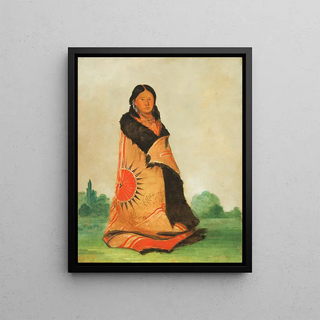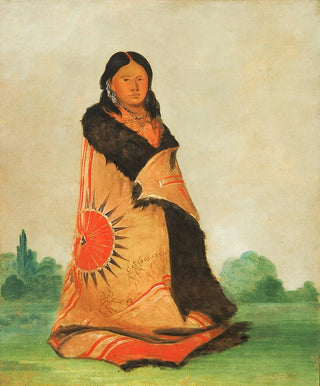Art print | Mong-shng-sha Curved Willow Wife of the Great Chief - George Catlin


View from behind

Frame (optional)
The Mong-shng-sha art print of the Curved Willow Wife of the Great Chief by George Catlin invites viewers to immerse themselves in the captivating world of Native American peoples, while revealing the virtuosity of an artist whose gaze captured the soul of his subjects. Through this piece, George Catlin does more than depict an iconic figure; he tells a story, that of a rich and complex culture that deserves to be celebrated. The canvas, imbued with a unique sensitivity, evokes the beauty and strength of Native American identity, while highlighting the deep bonds that connect man to nature. Contemplating this work transports the viewer on a timeless journey, where every detail seems to whisper tales of a bygone era.
Style and uniqueness of the work
Catlin's style is distinguished by its realistic approach and his ability to capture the emotions of his subjects. In Mong-shng-sha, he manages to convey a psychological depth that goes beyond mere representation. The vibrant colors and rich textures of the canvas create an immersive atmosphere, allowing the viewer to feel the quiet strength of the Great Chief's wife. The figure's posture, both majestic and serene, evokes timeless dignity. Elements of nature, integrated harmoniously into the composition, emphasize the interconnectedness between man and his environment. With his distinctive style, Catlin succeeds in immortalizing not only a person but also a culture and a worldview, offering a window into a often little-known past.
The artist and his influence
George Catlin, 19th-century artist and ethnographer, dedicated his life to documenting the lifestyles of Native American tribes before their existence was profoundly disrupted by colonial expansion. His work goes far beyond simple painting; it is a true act of memory, an effort to preserve a disappearing culture. Catlin traveled across the United States, meeting chiefs and members of various tribes, and his works reflect these encounters. As a pioneer of ethnographic art,

Matte finish

View from behind

Frame (optional)
The Mong-shng-sha art print of the Curved Willow Wife of the Great Chief by George Catlin invites viewers to immerse themselves in the captivating world of Native American peoples, while revealing the virtuosity of an artist whose gaze captured the soul of his subjects. Through this piece, George Catlin does more than depict an iconic figure; he tells a story, that of a rich and complex culture that deserves to be celebrated. The canvas, imbued with a unique sensitivity, evokes the beauty and strength of Native American identity, while highlighting the deep bonds that connect man to nature. Contemplating this work transports the viewer on a timeless journey, where every detail seems to whisper tales of a bygone era.
Style and uniqueness of the work
Catlin's style is distinguished by its realistic approach and his ability to capture the emotions of his subjects. In Mong-shng-sha, he manages to convey a psychological depth that goes beyond mere representation. The vibrant colors and rich textures of the canvas create an immersive atmosphere, allowing the viewer to feel the quiet strength of the Great Chief's wife. The figure's posture, both majestic and serene, evokes timeless dignity. Elements of nature, integrated harmoniously into the composition, emphasize the interconnectedness between man and his environment. With his distinctive style, Catlin succeeds in immortalizing not only a person but also a culture and a worldview, offering a window into a often little-known past.
The artist and his influence
George Catlin, 19th-century artist and ethnographer, dedicated his life to documenting the lifestyles of Native American tribes before their existence was profoundly disrupted by colonial expansion. His work goes far beyond simple painting; it is a true act of memory, an effort to preserve a disappearing culture. Catlin traveled across the United States, meeting chiefs and members of various tribes, and his works reflect these encounters. As a pioneer of ethnographic art,






